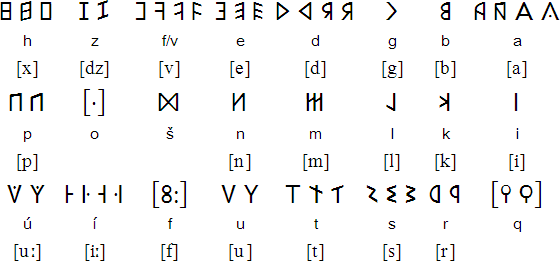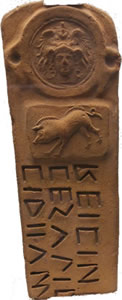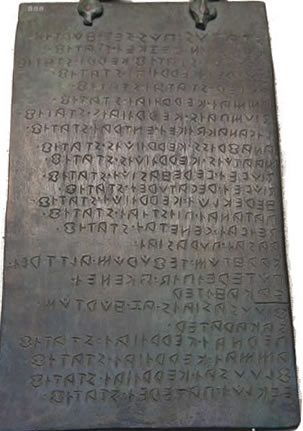Oscan was an Italic language spoken in southern Italy between about the 5th and 1st centuries BC. It was spoken by the Samnites, Aurunci (Ausones) and the Sidicini in the in Samnium, Campania, Lucania and Abruzzo. After the territory occupied by the Oscans was conquered by Rome in the first century AD, the Oscan language and culture disappeared.
Oscan was related to Latin and Umbrian, and is known from a number of inscriptions. It was written with the Latin and Greek alphabets, and with its own alphabet, which was adapted from the Etruscan alphabet sometime in the 7th century BC.


A terracotta marker with an Oscan inscription and stamps showing a helmeted Athena and a boar. This marker was found in a tomb near Capua in Italy and dates from 300-250 BC. The inscription reads "VIRIIUM VESULLIA[IS] DEIVIN[AIS], 'of the Virrii family for the divine festival of the Vesulias'. Such stamps appear on currency, and may devote gifts of money by the Virri family.

This bronze tablet with an Oscan inscription dates from 300-100 BC and is thought to be from Agnone or Capracotta. The inscription is about the dedication of statues of various deities.
Photos by Simon Ager, taken in the British Museum.
Information about Oscan | Numbers
Information about Oscan
https://en.wikipedia.org/wiki/Oscan_language
http://www.sanniti.info/smliny.html
https://www.britannica.com/topic/Oscan-language
http://tied.verbix.com/tree/ital/oscan.html
http://www.languagesgulper.com/eng/Oscan.html
https://archive.org/details/grammarofoscanum00buckuoft
A Grammar of Oscan and Umbrian
http://archive.org/details/cu31924074486501
ALPHABETUM - a Unicode font
for ancient scripts, including Classical & Medieval Latin, Ancient Greek, Etruscan, Oscan, Umbrian, Faliscan, Messapic, Picene, Iberian, Celtiberian, Gothic, Runic, Old & Middle English, Hebrew, Sanskrit, Old Nordic, Ogham, Kharosthi, Glagolitic, Anatolian scripts, Phoenician, Brahmi, Imperial Aramaic, Old Turkic, Old Permic, Ugaritic, Linear B, Phaistos Disc, Meroitic, Coptic, Cypriot and Avestan.
https://www.typofonts.com/alphabetum.html
Faliscan, Latin, Oscan, South Picene, Umbrian
A-chik Tokbirim, Adinkra, ADLaM, Armenian, Avestan, Avoiuli, Bactrian, Bassa (Vah), Beitha Kukju, Beria (Zaghawa), Borama / Gadabuursi, Carian, Carpathian Basin Rovas, Chinuk pipa, Chisoi, Coorgi-Cox, Coptic, Cyrillic, Dalecarlian runes, Elbasan, Etruscan, Faliscan, Fox, Galik, Georgian (Asomtavruli), Georgian (Nuskhuri), Georgian (Mkhedruli), Glagolitic, Global Alphabet, Gothic, Greek, Hurûf-ı munfasıla, Irish (Uncial), Kaddare, Kayah Li, Khatt-i-Badí’, Khazarian Rovas, Koch, Korean, Latin, Lepontic, Luo Lakeside Script, Lycian, Lydian, Manchu, Mandaic, Mandombe, Marsiliana, Medefaidrin, Messapic, Mongolian, Mro, Mundari Bani, Nag Chiki, Naasioi Otomaung, N'Ko, North Picene, Novo Tupi, Nyiakeng Puachue Hmong, Odùduwà, Ogham, Old Church Slavonic, Oirat Clear Script, Ol Chiki (Ol Cemet' / Santali), Old Italic, Old Nubian, Old Permic, Ol Onal, Orkhon, Osage, Oscan, Osmanya (Somali), Pau Cin Hau, Phrygian, Pollard script, Runic, Székely-Hungarian Rovás (Hungarian Runes), South Picene, Sutton SignWriting, Sunuwar, Tai Viet, Tangsa, Todhri, Toto, Umbrian, (Old) Uyghur, Wancho, Yezidi, Zoulai
Page last modified: 15.03.23
[top]
You can support this site by Buying Me A Coffee, and if you like what you see on this page, you can use the buttons below to share it with people you know.

If you like this site and find it useful, you can support it by making a donation via PayPal or Patreon, or by contributing in other ways. Omniglot is how I make my living.
Note: all links on this site to Amazon.com, Amazon.co.uk
and Amazon.fr
are affiliate links. This means I earn a commission if you click on any of them and buy something. So by clicking on these links you can help to support this site.
[top]